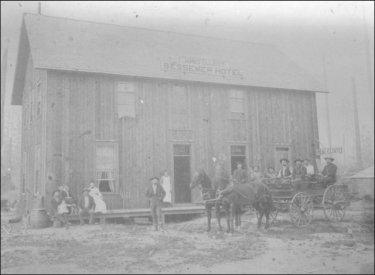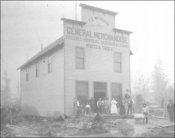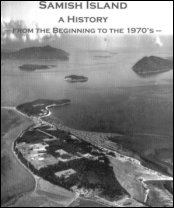The detail of this circa-1890 Elliott's Bessemer Hotel is stunning. First, it was a very substantial structure in the tiny town that formed on the north shore of the Skagit River, east of Lyman and Hamilton, and opposite Birdsey Minkler's original sawmill on the south shore. The von Pressentin family owned a gravity-powered ferry that transported goods, people, horses and wagons across the river. Otto Pressentin's caption notes on the photo: [from left to right] Mr. and Mrs. James and Alice [Jarman] Elliott (holding their daughter, [Mabel], granddaughter of Bill Jarman); William Snover and wife, later owners of Marblemount Hotel; George Gallagher; Ted the cook (in white apron); Charles Pressentin (in black hat in the doorway, father of Otto); two men leaning against wall unknown. On wagon, l. to r.: Elmer Wilson, son of Tom Wilson, Grandy creek settler; [writing is blurred here, either Walter Burleigh, who possibly platted the area around Bessemer, or Charles Hager, who is in dark shirt, homesteaded up Finney creek]; Albert Zabel (white shirt, stage owner and driver); Tom Wilson, Grandy Lake settler.
Other Pressentin notes on photo. Note 1: James Elliott Bessemer Hotel, later called the Birdsview Hotel, dated in the "early '90s." [Had to be about 1892 because of the Elliott baby, Mabel, who was born the year before.] Note 2: Bessemer Hotel in Birdsview was named for the new townsite about a little north and east of earlier Birdsview, but the townsite never prospered, so the hotel was later renamed Birdsview. Note 3: New townsite platted a mile northeast of Birdsview, was supposed to overrun and absorb Birdsview, but the reverse occurred and Bessemer was overrun and absorbed by Birdsview. From the John Wicker collection, apparently originally from the Otto Pressentin collection.
|

 810 Central Ave.,
810 Central Ave., 



